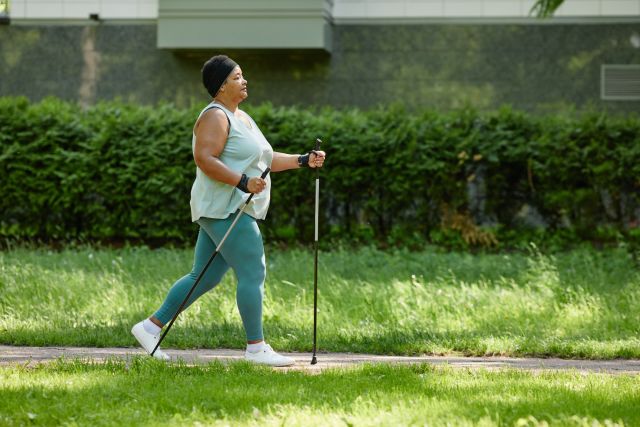Updated on October 31, 2023.
You may have heard about the value of getting in a certain number of steps each day. Some studies suggest 4,000 is the optimal minimum, while others say that you should aim for 7,000 or even 10,000.
The Centers for Disease Control and Prevention (CDC) recommends measuring daily exercise in time increments, rather than steps. They suggest that everyone should get at least 150 minutes per week of moderate-intensity cardiovascular exercise (like brisk walking). That means even 20 or 30 minutes of walking per day can bring lasting health benefits.
Setting a goal of reaching a particular number—whether of steps or minutes—is one way to motivate yourself to walk each day. Here are eight other ways to pump up your walks.
Go up (and down)
Do 15 minutes of a 35-minute walk on hills, not flat ground, and you'll burn close to 100 extra calories, according to walking guru Mark Fenton, author of The Complete Guide to Walking: For Health, Weight Loss, and Fitness.
Walking hills can also help tone your backside. If you're on a treadmill, hike your incline by 15 percent for 15 minutes of your walk. Break things up by raising the incline for a few minutes, then lowering it, then putting it back up again.
Make it a game
Pick up the pace for 30 seconds every time you see a dog, a mailbox, a red car, or someone sipping coffee. Then, let your pace go back to normal (but no slower than that) while you catch your breath. Making a game of it can keep your walks more interesting and help increase your speed over time.
Tip: When you accelerate for short bursts of speed, make sure that your steps are quicker, but not smaller. Next week, try making the faster parts 5 seconds longer. Keep at it.
Get (a little) speedy
If you're walking 20-minute miles, make it your goal this week to do one 19-minute mile each time you walk. Even if you go faster for just 1 mile of your 3-mile circuit, you're making progress. Work up to 19 minutes for each mile of your workout. Once you can do that, try doing 1 mile at 18 minutes.
Do 5 minutes more, here and there
This week, either add 5 minutes to three walks, or add a 15-minute mile to one walk. Your choice. Take a longer loop back home or reset your treadmill timer. Try to keep up the pace as you go.
Add music
There is plenty of evidence that picking out your own music and exercising with it can boost motivation, performance, and enjoyment. So try strolling to music with a makes-you-want-to-move beat. It can give you that lift you need to walk a little faster and further.
Go Nordic
You may be able to burn extra calories, increase fitness, improve mobility, and lower your risk of some chronic illnesses by using springy Nordic walking poles when you head out. In part, that’s because they work the upper body in addition to your lower body. And even though you're doing more when you use poles—like moving your arms and walking taller—your stroll session might feel easier, as the poles help stabilize you.
Add some heft
Walking with weights can be a great added challenge to your workout, but be careful. Wearing ankle or wrist weights while walking can lead to muscles developing in an imbalanced way. It might also cause tendon or joint injuries.
Instead, try a weighted vest, making sure it doesn’t exceed 10 percent of your body weight. If you have spine or neck problems, check with your healthcare provider first. Besides just making the walk more vigorous, weighted vests can help stimulate the growth of new bone cells.
Invite a buddy
Instead of catching up with friends in a café, hanging out with family in the living room, or having a discussion around a meeting table, invite people from your network to walk with you. Walking with others has numerous benefits, including maintaining and improving motivation and pace.







